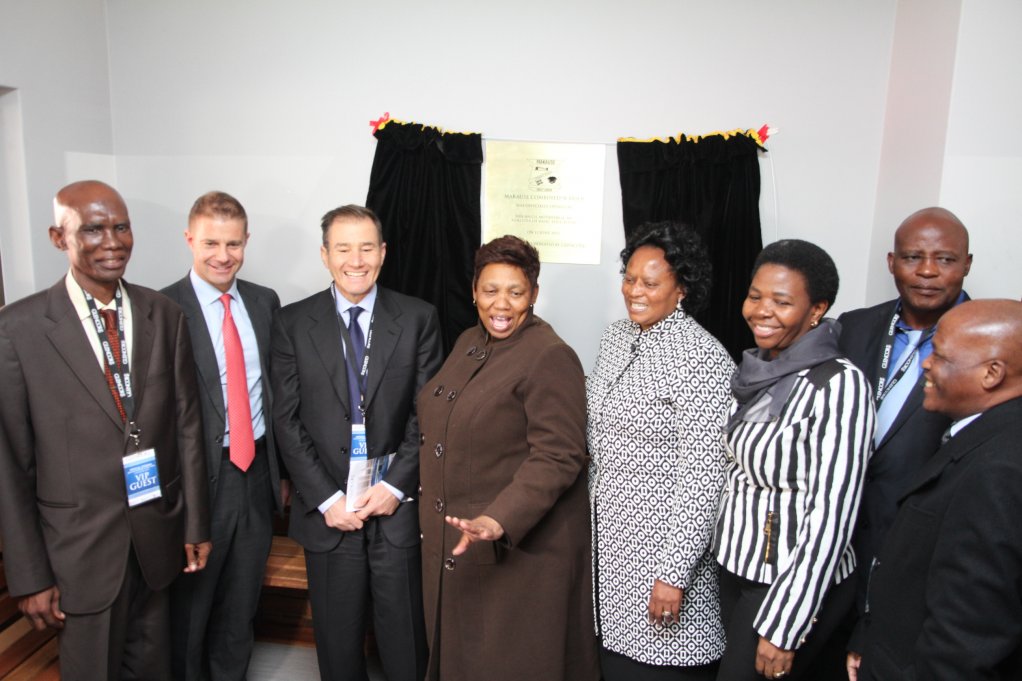
HANDOVER CEREMONY At Glencore R75-million school donation are (from left) principal AS Mahlangu; Glencore Coal South Africa CEO Clinton Ephron; Glencore CEO Ivan Glasenberg; Basic Education Minister Angie Motshekga, Education MEC Reginah Mhaule, Emalahleni Mayor Salome Sithole, School Governing Body chairperson DP Maimela; District Basic Education Director Jerry Mabena.
Photo by: Duane Daws
Mining and marketing giant Glencore sees a slight undersupply of coal on the horizon.
Speaking on video to Creamer Media senior staff writer Zandile Mavuso at Glencore’s donation of a new R75-million state-of-the-art school to South Africa’s Department of Basic Education, Glencore CEO IvanGlasenberg outlined higher expected future demand for seaborne coal, owing to the world’s biggest coal exporter, Indonesia, absorbing a large volume of previously exported coal for its own new coal-fired power stations and India, China and Korea also requiring coal for new thermal stations.
“There seems to be a little bit of, we believe, undersupply,” Glasenberg commented in the attached video interview.
“We’re still very positive on coal in the future,” he said, putting current global seaborne coal demand at some 950-million tonnes of coal a year, with Indonesia poised to supply progressively less than its current 450-million tonnes a year over the next five years.
While the availability of shale gas was allowing the US to use less coal, new coal-fired power stations in India, China, Korea and Indonesia were driving demand.
From 2015 to 2020, at least 150-million tonnes of Indonesian coal would be used domestically rather than being exported.
As coal remained the cheapest form of energy, developing nations were still building and developing coal-fired stations to grow their economies.
India, which was currently importing 200-million tonnes of coal a year, was set to increase that to 250-million tonnes and potentially 300-million tonnes of coal a year.
The seaborne coal market would thus continue to grow, with the potential for wealthier nations to assist developing nations to burn coal in a cleaner manner, which was possible.
“We’ve said before that wealthier nations should assist the poorer nations to develop better coal-fired facilities so that they can burn coal in a cleaner manner,” Glasenberg said.
On when the time would be right for more investment in coal mining, he outlined the necessity of that being triggered by much higher demand than supply, “which right now looks pretty balanced”.
While he expected demand to rise in 2017 and 2018, he strongly reiterated the London-, Hong Kong- and Johannesburg-listed company’s firm policy of only investing in increased production when the company was certain of not hurting existing production.
“You’ve got to assess the future market before you put in more of whichever commodity you are producing and you’ve got to assess demand. For coal, if the demand is not there, we’ll cut back production,” Glasenberg promised. (Watch video attached)
Investec Securities said in a note last week that the projection by Australia’s Queensland Resources Council of record coal exports from Queensland this year and 5% higher coal exports from New South Wales supported the Glencore view.
“Prices may be weak but demand remains strong and consumers must be gleeful,” commented Investec, which added that exports were being buoyed by demand from India, owing to its shifted emphasis towards cleaner coals.